| Location | Taksebt, Tizi Ouzou Province, Algeria |
|---|---|
| Coordinates | 36°54′03.4″N4°09′34.5″E / 36.900944°N 4.159583°E |
Rusippisir was a Phoenician, Carthaginian, and Roman town on Algeria's Mediterranean coast at the site of present-day Taksebt.
| Location | Taksebt, Tizi Ouzou Province, Algeria |
|---|---|
| Coordinates | 36°54′03.4″N4°09′34.5″E / 36.900944°N 4.159583°E |
Rusippisir was a Phoenician, Carthaginian, and Roman town on Algeria's Mediterranean coast at the site of present-day Taksebt.
Rusippisir is the latinization of the town's Punic name, which probably meant "Cape Rosemary". [1]
Rusippisir was located at Cape Tedless (French : Cap Tedles), Algeria, [1] the site of present-day Taksebt in Tizi Ouzou.
Rusippisir was established as a colony on the trade route between Phoenicia and the Strait of Gibraltar. Its port was nearby Iomnium (present-day Tigzirt). It later fell under Carthaginian and then, after the Punic Wars, Roman hegemony. Punic steles in Rusippisir continued to be produced well into the imperial period and there was tophet in the town. [1]
In antiquity, Rusippisir was the site of a Christian bishopric. This was revived in the 20th century as a Catholic titular see (Latin : Dioecesis Rusubisiritana; Italian : Rusibisir). [2] [3]
Thapsus, also known as Tampsus and as Thapsus Minor to distinguish it from Thapsus in Sicily, was a Carthaginian and Roman port near present-day Bekalta, Tunisia.
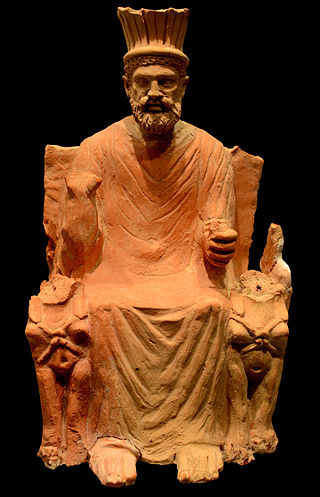
Baal Hammon, properly Baʿal Ḥammon or Baʿal Ḥamon, meaning "Lord Hammon", was the chief god of Carthage. He was a weather god considered responsible for the fertility of vegetation and esteemed as King of the Gods. He was depicted as a bearded older man with curling ram's horns. Baʿal Ḥammon's female cult partner was Tanit.

Kerkouane or Kerkuane is the site of an ancient Punic city in north-eastern Tunisia, near Cape Bon. Kerkouane was one of the most important Punic cities, with Carthage, Hadrumetum, and Utica. This Phoenician city was probably abandoned during the First Punic War and was not rebuilt by the Romans. It had existed for almost 400 years.
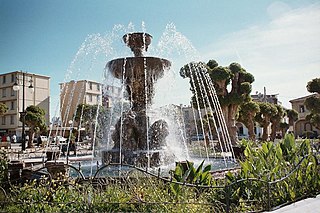
Cherchell is a town on Algeria's Mediterranean coast, 89 kilometers (55 mi) west of Algiers. It is the seat of Cherchell District in Tipaza Province. Under the names Iol and Caesarea, it was formerly a Roman colony and the capital of the kingdoms of Numidia and Mauretania.

The Punic people, or Carthaginians, were a Semitic people in the Western Mediterranean who migrated from Tyre, Phoenicia to North Africa during the Early Iron Age. In modern scholarship, the term Punic, the Latin equivalent of the Greek-derived term Phoenician, is exclusively used to refer to Phoenicians in the western Mediterranean, following the line of the Greek East and Latin West.
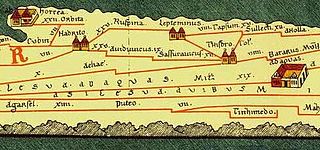
Leptis or Lepcis Parva was a Phoenician colony and Carthaginian and Roman port on Africa's Mediterranean coast, corresponding to the modern town Lemta, just south of Monastir, Tunisia. In antiquity, it was one of the wealthiest cities in the region.
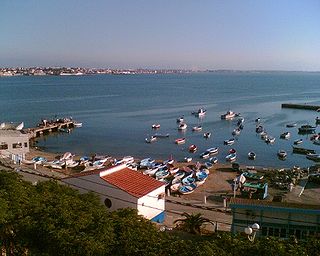
Tamentfoust, the classical Rusguniae and colonial La Pérouse, is a site in the Dar El Beïda District of Algiers in Algeria.

Carthage was a settlement in what is now known as modern Tunisia that later became a city-state and then an empire. Founded by the Phoenicians in the ninth century BC, Carthage reached its height in the fourth century BC as one of the largest metropolises in the world and the centre of the Carthaginian Empire, a major power in the ancient world that dominated the western and central Mediterranean Sea. Following the Punic Wars, Carthage was destroyed by the Romans in 146 BC, who later rebuilt the city lavishly.
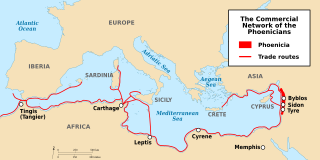
The culture of the ancient Phoenicians was one of the first to have had a significant effect on the history of wine. Phoenicia was a civilization centered in current day Lebanon. Between 1550 BC and 300 BC, the Phoenicians developed a maritime trading culture that expanded their influence from the Levant to North Africa, the Greek Isles, Sicily, and the Iberian Peninsula. Through contact and trade, they spread not only their alphabet but also their knowledge of viticulture and winemaking, including the propagation of several ancestral varieties of the Vitis vinifera species of wine grapes.

Djinet, the classical Cissi, is a port town and commune in the Bordj Menaïel District of Boumerdès Province, Algeria, east of the mouth of the Isser River and around Cape Djinet. As of 2008, the population of the municipality is 21,966.
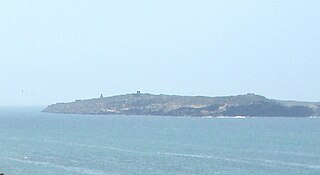
Mogador Island is the main island of the Iles Purpuraires near Essaouira in Morocco. It is about 3 kilometres long and 1.5 kilometres wide, and lies about 1.5 kilometres from Essaouira.

Igilgili was a Berber town and a Phoenician, Carthaginian, and Roman colony in located in present-day Jijel, Algeria.

Cartennae or Cartenna was an ancient Berber, Carthaginian, and Roman port at present-day Ténès, Algeria. Under the Romans, it was part of the province of Mauretania Caesariensis.

Ounga, also known as Younga and Jounga, is an archaeological site on the Mediterranean coast of Tunisia, located 45 km (28 mi) south of Sfax along the Mediterranean coast. The area is also known for its oil fields.
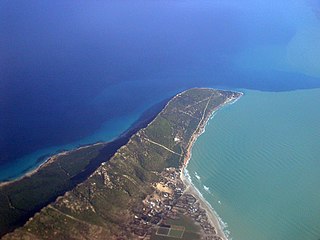
Cape Farina is a headland in Bizerte Governorate, Tunisia. It forms the northwestern end of the Gulf of Tunis. The Tunisian towns of Ghar el-Melh, Rafraf, Lahmeri, and the beach of Plage Sidi Ali Mekki Est are located along the peninsula.

Iomnium was a Phoenician, Carthaginian, and Roman port on Algeria's Mediterranean coast at the site of present-day Tigzirt.
Gunugus or Gunugu was a Berber and Carthaginian town in northwest Africa in antiquity. It passed into Roman control during the Punic Wars and was the site of a colony of veteran soldiers. It survived the Vandals and Byzantines but was destroyed during the Muslim invasion of the area.
Rusazus was a Phoenician, Carthaginian, and Roman town located near Cape Corbelin, Algeria. Its ruins are near the town of Azeffoun.
Rusubbicari was a Phoenician and Carthaginian colony and Roman town. It has been tentatively identified with ruins at Zemmouri El Bahri, Algeria. The Roman town was in the province of Mauretania Caesariensis.

Masinissa, also spelled Massinissa, Massena and Massan, was an ancient Numidian king best known for leading a federation of Massylii Berber tribes during the Second Punic War, ultimately uniting them into a kingdom that became a major regional power in North Africa. He is regarded as the founder of the first algerian state.